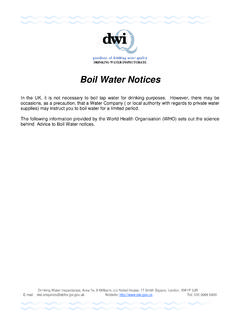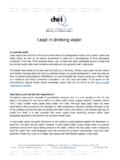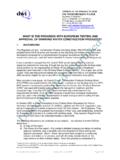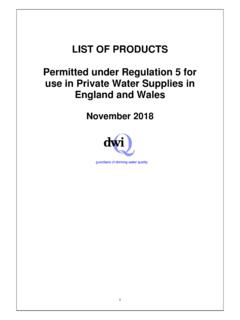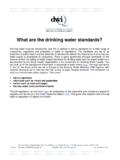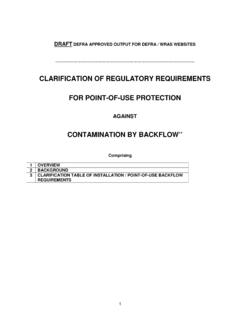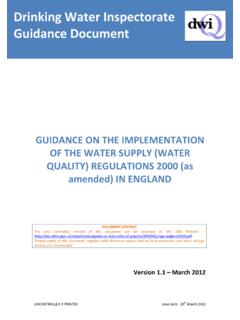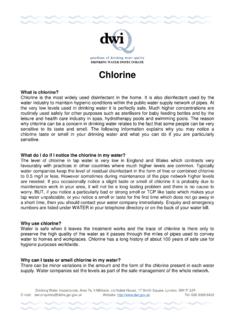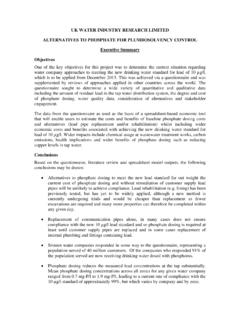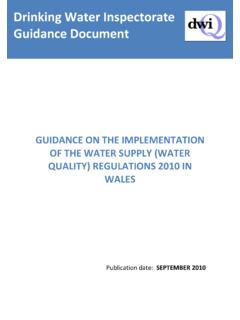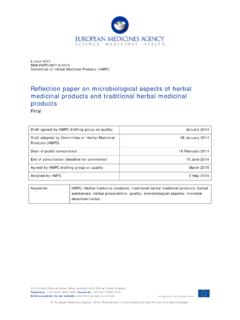Transcription of REVIEW OF TEST METHODS AND CRITERIA FOR …
1 REVIEW OF TEST METHODS AND CRITERIA FOR ASSESSING TASTE AND OFF-TASTE i EXECUTIVE SUMMARYOBJECTIVES To REVIEW and critically appraise available test METHODS for assessing the taste and off-taste in drinking water and where possible propose alternatives or new technologies which may be applicable. REASONS Taste and odour problems in drinking water present a difficult customer relations problem for water companies. A clear evaluation of the nature of a taste and odour problem in drinking water represents the first step to treatment and control measures. However, there are particular problems associated with the application of qualitative and quantitative sensory METHODS to assess taste and odour in drinking water. CONCLUSIONS Taste and odour assessment using sensory METHODS is apparently a basic and simple test which consumers can do themselves. However, it is essentially a subjective assessment which has considerable uncertainty.
2 Published standard METHODS for the assessment of tastes and odours in drinking water suffer from methodological and interpretational problems and there are significant practical and resourcing problems associated with applying some METHODS , including the European Standard method, which has received criticism. The SCA and CEN METHODS are not per se METHODS for investigating the causes of tastes and odours but provide a means of assessing compliance with regulatory standards based on the response of panellists to tastes and odours in samples and diluted samples with respect to reference samples. The use of quantitative taste and odour measurements using threshold numbers are the main means of assessing compliance with regulations and should not be expected to necessarily be of value in dealing with customer complaints. Whilst threshold odour or taste (flavour) numbers are a useful method for obtaining information on taste or odour thresholds for specific chemicals, when applied in the SCA and CEN METHODS they simply provide a subjective assessment of the presence or absence of a flavour or odour to panellists.
3 They do not provide specific information relating to the causes of any tastes or odours detected and cannot distinguish between effects caused by single chemicals or by mixtures of different chemicals. Although sensory tests based on threshold measurements are often referred to as quantitative , they should really be regarded as being semi-quantitative , particularly as the nature of the organoleptic chemicals is usually unknown. Despite the limitations of the threshold approach it can be applied as a relative measure by treatment plant operators to monitor changes in water quality. Taste and odour tests used in the USA adopts a higher sample testing temperature than in the CEN and SCA METHODS . Whilst a move to revise the SCA or CEN METHODS to incorporate a higher test temperature may intuitively appear to lead to increased method ii sensitivity, this requires further investigation.
4 There is a need to evaluate how a change in test temperature influences vapour phase concentrations for a range of relevant odourous chemicals which may have widely differing physicochemical properties. There does not appear to be any background literature which demonstrates the actual benefits that a higher test temperature provides. A decision to recommend a revision of current test method temperatures should be based on an objective comparison of practical vapour pressure improvements with sensory detection errors. This would establish whether any real practical improvements result from increases in CEN or SCA test method temperatures. The Drinking Water Directive, Annex A, Part C, states that the taste and odour of drinking water should be acceptable to consumers and subject to no abnormal change . However, the threshold tests used for compliance monitoring are non-specific, semi-quantitative and essentially subjective.
5 These inherents weaknesses, coupled with the lack of definition regarding what is acceptable to consumers undermines the validity of taste and odour compliance monitoring. Threshold measurements do not take account of the offensiveness of tastes or odours or of the fact that different chemicals may have different dose responses, that these are non- linear and that different panellists may have widely differing personal sensitivities to chemicals. The inherent lack of precision in sample screening using threshold numbers limits their utility. Furthermore, the fact that compliance with statutory regulations is possible if 50% of the panellists cannot perceive a taste or odour in a sample diluted with three volumes of reference water is unlikely to reassure consumers, particularly if they fall within the more sensitive 50% of the population. Consequently, compliance with the requirements of threshold tests does not necessarily provide guarantees that customers will not find drinking water unobjectionable in terms of taste and odour.
6 Some investigation as to how standard METHODS cope in practice with a wide range of substances which cause tastes or odours, particularly volatile chemicals, is required. Also, there is a need to incorporate a satisfactory protocol to select and calibrate the sensitivity of panellists and to monitor their performance within current standard threshold METHODS . Addressing this may reduce some of the subjectivity of the METHODS . At present there do not appear to be any better sensory METHODS available to measure the compliance with dilution-based regulatory limits. There is certainly scope for investigating to what extent meeting a quantitative standard for taste and odour actually ensures meeting consumers perceptions of acceptability and what proportion of the population are likely to be satisfied. In order to investigate the sources of taste and odour problems in drinking water and to identify the chemical or microbiological causes more elaborate METHODS such as Flavour Profile Analysis and analytical screening need to be considered.
7 The output of such testing is useful for process development and long-term monitoring of supplies with taste and odour problems and the results may be correlated with analyses of traces of organic chemicals in water samples. However, the results of FPA cannot be readily interpreted for the purposes of assessing regulatory compliance. Also these approaches involve
